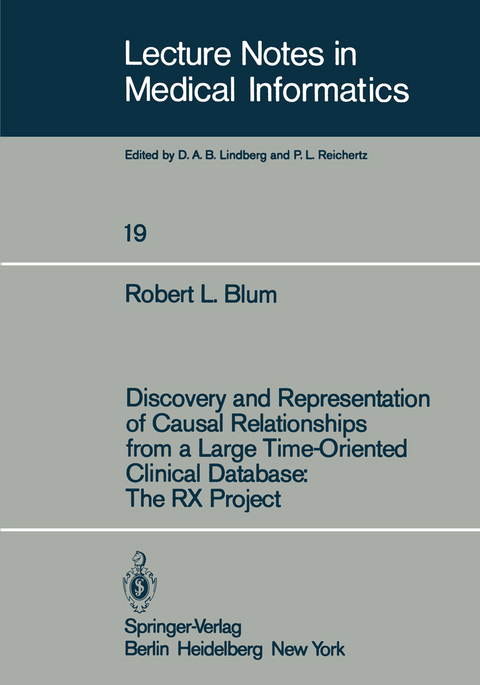
Discovery and Representation of Causal Relationships from a Large Time-Oriented Clinical Database: The RX Project
Springer Berlin (Verlag)
978-3-540-11962-3 (ISBN)
1. The RX Project: An Overview.- 1.1. Introduction.- 1.2. Evolution of Empirical Knowledge.- 1.3. Inference from Non-Randomized Databases: The Problems.- 1.4. Causal Models: The RX Knowledge Base.- 1.5. The Discovery Module.- 1.6. The RX Knowledge Base: Its Role.- 1.7. The Study Module.- 1.8. Conclusions.- 2. The Time-Oriented Database.- 2.1. Introduction.- 2.2. Computer Facilities.- 2.3. The RX Database: Overview of the Logical Structure.- 2.4. Database Implementation Issues.- 2.5. Summary.- 3. The RX Knowledge Base: An Overview.- 3.1. Introduction.- 3.2. Categories of Schema Properties.- 3.3. Contents of the RX Knowledge Base.- 3.4. Inheritance Mechanisms.- 3.5. The RX Knowledge Base: Interactive Use.- 4. The Properties and Representation of Causal Relationships.- 4.1. An Operational Definition of Causality.- 4.2. Features of Individual Cause/Effect Relationships.- 4.3. Representation of Causal Relationships.- 4.4. Representation of Causal Links in RX.- 4.5. AI Research on Causal Models.- 4.6. Conclusion.- 5. Derived Variables, Proxy Variables, and Time-Dependent Access Functions.- 5.1. Introduction.- 5.2. The Derivation of Interval-Events.- 5.3. Time-Dependent Database Access Functions.- 5.4. Latent Variables and Proxies.- 6. The Discovery Module.- 6.1. Introduction.- 6.2. The Algorithm.- 6.3. Automated Inference: A Comparison with Other Work.- 7. The Study Module.- 7.1. Overview.- 7.2. Determination of Feasibility of Study.- 7.3. Confounding Variables and Causal Dominators.- 7.4. Determination of Methods for Controlling Confounding Variables.- 7.5. Choice of Study Design and Statistical Method.- 7.6. Formatting of Database Access Functions.- 7.7. Determination of Eligibility Criteria.- 7.8. Statistical Analysis: Fitting the Model.- 7.9. Interpretation of Results.- 7.10. Incorporation of the New Causal Relationship into the KB.- 8. Statistical Analysis of Longitudinal Data.- 8.1. The Longitudinal Model.- 8.2. Regression Analysis.- 8.3. Adequacy of the Model.- 9. Medical Results.- 9.1. Introduction.- 9.2. Effects of Prednisone.- 9.3. Effect of Prednisone on Cholesterol.- 9.4. Refinements,.- 10. Summary, Applications, Future Development.- 10.1. Introduction.- 10.2. Project Summary.- 10.3. Applicability of the RX Prbject.- 10.4. Accession of Data 189 10.4.1. Post-Marketing Surveillance of Drugs.- 10.5. The RX Project: Limitations and Future Development.
| Erscheint lt. Verlag | 1.12.1982 |
|---|---|
| Reihe/Serie | Lecture Notes in Medical Informatics |
| Zusatzinfo | XIX, 242 p. |
| Verlagsort | Berlin |
| Sprache | englisch |
| Maße | 170 x 244 mm |
| Gewicht | 435 g |
| Themenwelt | Mathematik / Informatik ► Mathematik ► Wahrscheinlichkeit / Kombinatorik |
| Studium ► Querschnittsbereiche ► Epidemiologie / Med. Biometrie | |
| Schlagworte | Correlation • Fitting • Medizinische Informatik • Regression Analysis • RX • Time |
| ISBN-10 | 3-540-11962-0 / 3540119620 |
| ISBN-13 | 978-3-540-11962-3 / 9783540119623 |
| Zustand | Neuware |
| Haben Sie eine Frage zum Produkt? |
aus dem Bereich


